By Dr. Stephanie Hsu
Tennis requires strength, speed, flexibility, balance, and coordination to create efficient, powerful strokes and to provide the agility to move quickly across the court. However, the repetitive motions put a significant amount of load on our muscles, ligaments, tendons, bones, and joints, putting us at higher risk of injury. To help prevent injury, it’s important to take the extra time off the court to do conditioning and training work.
This is where the concept of the kinetic chain makes a significant difference for all players. The kinetic chain links coordinated movements through the different parts of our body to produce power, accuracy, and efficiency starting from the ground up through our racquet. Energy is created and stored through our movement patterns and muscles as we push off the ground.
For example, to create power and spin on a serve, we start with the loading phase. Here, the lower body pushes off the ground and our trunk starts to rotate in order to begin storing this elastic type of energy, almost like stretching a rubber band. Next is the cocking phase, when the trunk begins to extend and rotate with our upper body and serving arm coming into play as it sets back. This helps create even more power and energy to funnel into our serving arm and through our racquets on contact. Third is the acceleration phase, where our lower body, trunk, and arm start to unwind and swing to transfer saved energy to move our racquet. Upon contact, the follow-through phase engages numerous muscles to slow down our arm and reset our legs and trunk to be ready for the next movement. This is the kinetic chain at work to create strokes. The more mobility, stability, and strength we have, the more efficient and coordinated we can make our kinetic chain, and therefore, improve play and decrease injury.
It takes quite a bit of coordination for our bodies to make tennis work. Thinking about how to take care of ourselves, link by link, allows us to stay on the court and enjoy the game.
Your kinetic chain links
The following tips will improve mobility, increase stability and strength, and maximize agility and power, while minimizing injuries on the court.
LOWER BODY
Feet/ankles
- Protects against: calf strains, Achilles tendonitis, plantar fasciitis
- Mobility move: heel cord/calf stretches
- Stability/Strength exercise: one leg stability balances
Knees
- Protects against: patellar and quadriceps tendinitis, meniscus tears
- Mobility move: hamstring and quadriceps stretches
- Stability/Strength exercise: step ups
Hips
- Protects against: glute strains, stiff hips and stiff on-court movement, low back pain
- Mobility move: hip flexor and iliotibial band stretches, piriformis (glute) stretches
- Stability/Strength exercise: lateral monster squat walks, hip bridges
TRUNK
Low back
- Protects against: low and upper back pain
- Mobility move: cobras
- Stability/Strength exercise: bird dogs, supermans
*One of the highest areas of injuries from juniors to the pros. Taking extra care of this area can help keep you much happier and comfortable on and off the court.
Trunk/core
- Protects against: abdominal tears, shoulder and upper arm injuries
- Mobility move: laying down crossover leg rotations
- Stability/Strength exercise: regular and side planks, resisted trunk rotations
UPPER BODY
Shoulder blades (scapula)
- Protects against: the constellation of shoulder and elbow injuries
- Mobility move: scapular reach forward and up
- Stability/Strength exercise: shoulder blade postural squeezes, I/Y/T shoulder extensions
*The shoulder blades are the base, stability, and most important protector of your posture, shoulder and upper arm.
Shoulder
- Protects against: rotator cuff strains and tears, labral tears, shoulder impingement
- Mobility move: cross body shoulder stretch, pectoralis (chest) snow angels
- Stability/Strength exercise: rotator cuff bands, dynamic resisted serve takeback
Elbow/Forearm
- Protects against: tennis elbow, golfer’s elbow
- Mobility move: forearm flexor and extensor stretches
- Stability/Strength exercise: eccentric extensor/flexor muscle and rotation resistance
Wrist/Hand
- Protects against: tendonitis, TFCC (triangular fibrocartilage complex) injuries
- Mobility move: prayer and inside-out prayer stretches
- Stability/Strength exercise: gyroscope stability, grip strengthening
Putting it all together
- Dynamic warm up before and static cool down stretches after play
- Mobility moves, stabilization and strength exercises following play or on tennis off days
- Start hydrating before and keep hydrating during your match
- Have fun!




